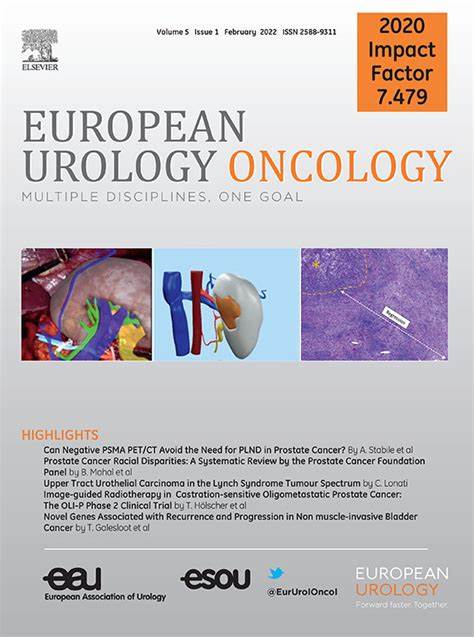Development and Validation of the UriMee Model: A Methylation-based Diagnostic Tool for Early Diagnosis of Urothelial Carcinoma
IF 9.3
1区 医学
Q1 ONCOLOGY
引用次数: 0
Abstract
Background and objective
Urothelial carcinoma (UC) is a common malignancy that imposes a significant health care burden. Current diagnostic methods are limited by their invasiveness and low sensitivity, particularly for detecting low-grade tumors. Noninvasive, accurate, and reliable diagnostic tests for an early diagnosis of UC are urgently needed.
Methods
UC-specific DNA methylation biomarkers were identified by combining public datasets from The Cancer Genome Atlas and Gene Expression Omnibus with a cohort from Renji Hospital (n = 50). Using the Least Absolute Shrinkage and Selection Operator regression, we developed a diagnostic model, termed the UriMee model, by selecting key biomarkers from a model cohort (n = 322) and subsequently validating it in an independent cohort (n = 131). The diagnostic performance of the assay was evaluated and compared with that of urine cytology.
Key findings and limitations
At 30% threshold probability, the UriMee model demonstrated high sensitivity (92%) and specificity (92%) in distinguishing UC cases, with particularly strong performance in early-stage tumors (83% sensitivity for Ta, 93% for T1, and 100% for Tis). It significantly outperformed urine cytology, offering greater sensitivity (90% vs 25%, p < 0.001) while maintaining comparable specificity. Additionally, the model was highly effective in identifying upper tract urothelial carcinoma (UTUC), achieving sensitivity of 96%. The study’s limitations include the necessity for larger multicenter studies and long-term follow-up to validate the findings and assess the test’s effectiveness across diverse populations, as well as its utility in monitoring disease progression and recurrence.
Conclusions
The UriMee test demonstrated high sensitivity and specificity, particularly in detecting early-stage tumors and UTUC, significantly outperforming traditional methods.
UriMee模型的开发和验证:一种基于甲基化的尿路上皮癌早期诊断工具。
背景和目的:尿路上皮癌(UC)是一种常见的恶性肿瘤,造成了重大的医疗负担。目前的诊断方法受其侵入性和低灵敏度的限制,特别是在检测低级别肿瘤时。迫切需要无创、准确、可靠的UC早期诊断测试。方法:结合来自癌症基因组图谱和基因表达综合数据库的公共数据集以及来自仁集医院的队列(n = 50),鉴定uc特异性DNA甲基化生物标志物。使用最小绝对收缩和选择算子回归,我们通过从模型队列(n = 322)中选择关键生物标志物,随后在独立队列(n = 131)中验证,开发了一个诊断模型,称为UriMee模型。评价了该检测的诊断性能,并与尿细胞学检测进行了比较。主要发现和局限性:在30%的阈值概率下,UriMee模型在区分UC病例方面表现出高灵敏度(92%)和特异性(92%),在早期肿瘤中表现尤其突出(Ta敏感性83%,T1敏感性93%,Tis敏感性100%)。结论:UriMee检测具有较高的灵敏度和特异性,特别是在检测早期肿瘤和UTUC方面,明显优于传统方法。
本文章由计算机程序翻译,如有差异,请以英文原文为准。
求助全文
约1分钟内获得全文
求助全文
来源期刊

European urology oncology
Multiple-
CiteScore
15.50
自引率
2.40%
发文量
128
审稿时长
20 days
期刊介绍:
Journal Name: European Urology Oncology
Affiliation: Official Journal of the European Association of Urology
Focus:
First official publication of the EAU fully devoted to the study of genitourinary malignancies
Aims to deliver high-quality research
Content:
Includes original articles, opinion piece editorials, and invited reviews
Covers clinical, basic, and translational research
Publication Frequency: Six times a year in electronic format
 求助内容:
求助内容: 应助结果提醒方式:
应助结果提醒方式:


